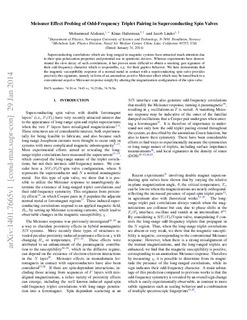| dc.contributor.author | Alidoust, Mohammad | |
| dc.contributor.author | Halterman, K | |
| dc.contributor.author | Linder, Jacob | |
| dc.date.accessioned | 2017-11-09T09:42:43Z | |
| dc.date.available | 2017-11-09T09:42:43Z | |
| dc.date.created | 2014-10-29T15:12:56Z | |
| dc.date.issued | 2014 | |
| dc.identifier.issn | 1098-0121 | |
| dc.identifier.uri | http://hdl.handle.net/11250/2465142 | |
| dc.description.abstract | Superconducting correlations which are long ranged in magnetic systems have attracted much attention due to their spin-polarization properties and potential use in spintronic devices. Whereas experiments have demonstrated the slow decay of such correlations, it has proven more difficult to obtain a smoking gun signature of their odd-frequency character which is responsible, e.g., for their gapless behavior. Here we demonstrate that the magnetic susceptibility response of a normal metal in contact with a superconducting spin valve provides precisely this signature, namely, in the form of an anomalous positive Meissner effect, which may be tuned back to a conventional negative Meissner response simply by altering the magnetization configuration of the spin valve. | nb_NO |
| dc.language.iso | eng | nb_NO |
| dc.publisher | American Physical Society | nb_NO |
| dc.title | Meissner effect probing of odd-frequency triplet pairing in superconducting spin valves | nb_NO |
| dc.type | Journal article | nb_NO |
| dc.description.version | submittedVersion | nb_NO |
| dc.source.volume | 89 | nb_NO |
| dc.source.journal | Physical Review B. Condensed Matter and Materials Physics | nb_NO |
| dc.source.issue | 5 | nb_NO |
| dc.identifier.doi | 10.1103/PhysRevB.89.054508 | |
| dc.identifier.cristin | 1168146 | |
| dc.description.localcode | © 2014 American Physical Society. This is the authors' manuscript to the article (preprint). | nb_NO |
| cristin.unitcode | 194,66,20,0 | |
| cristin.unitname | Institutt for fysikk | |
| cristin.ispublished | true | |
| cristin.fulltext | preprint | |
| cristin.qualitycode | 2 | |
